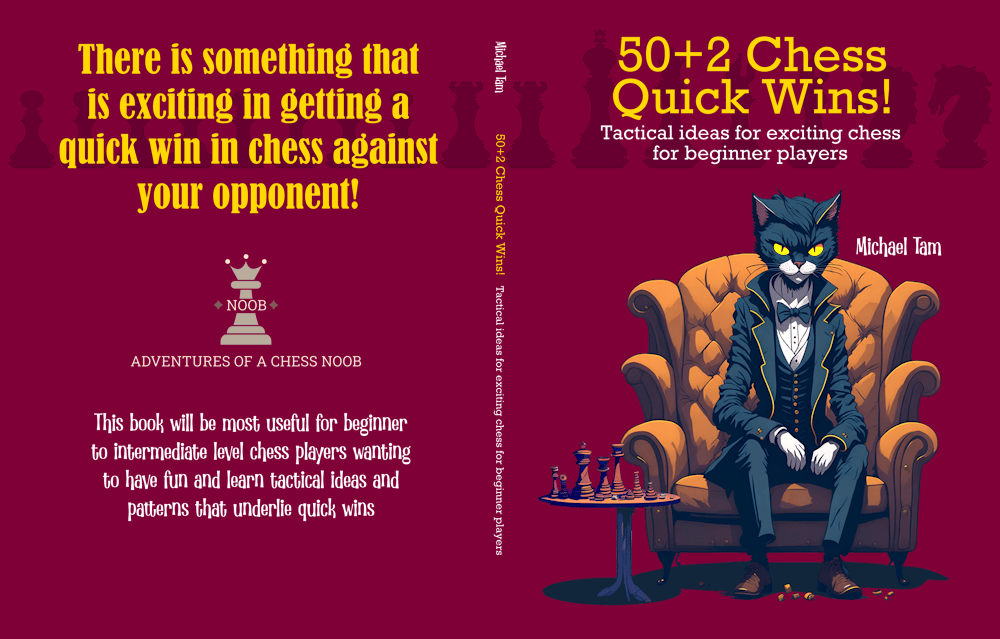
Bishop d3 opening? 🤔 NO! ⚡ Quick Wins #89 & 90
#quickwins #viennagambit #weirdopenings #brilliant
Today’s Quick Wins article and video is a two-in-one! I played these two games back-to-back against the same Random Noob, who played an interesting idiosyncratic set up for their first three moves – developing their king’s pawn, king’s knight, and then, the king’s bishop to the d-file. We’ll have a look at why this approach is somewhat suboptimal, and arguably, a mistake.
![]()
Game 1: Vienna Gambit Declined… 3… Bd6
https://www.chess.com/analysis/library/3FRaXLuuwU
I had the white pieces in the first game and as my opponent with the black pieces played their approach, it allowed me to play the Vienna Gambit (1. e4 e5 2. Nc3 Nf6 3. f4). Against the Vienna Gambit, developing the bishop to the d-file ostensibly defends Black’s e5-pawn. However, this is a mistake, and arguably a blunder (3… Bd6??) as White now as the lovely tactic (4. fxe5! Bxe5 5. d4! Bd6 6. e5), forking Black’s bishop and knight. Black opts to desperado their bishop, but after (6… Bxe5 7. dxe5), White has a very thematic attack on Black’s f6-knight.
The best move for Black is to un-develop their knight to g8, which can be difficult to stomach. Black, flustered by the opening manoeuvre, now blunders their second piece with (7… Nh5??), putting the knight on a diagonal controlled by my queen (8. Qxh5)!
Black, castles their king, but the damage has been done. As I have a massive advantage in both material and development, checkmate comes only a few moves later by coordinating my bishop pair and queen. The crushing dominance is evident that on checkmate, every single one of Black’s remaining pieces were still on Black’s back rank!
![]()
Game 2: King’s Pawn Opening, King’s Knight Var., 3. Bd3
https://www.chess.com/analysis/library/24VTiFV1Rg
My opponent immediately asked for a rematch, and I obliged. This time, they played White and I Black. Notably, they followed their somewhat unusual opening approach (1. e4 e5 2. Nf3 Nc6 3. Bd3). As they moved first, this bishop move is not a disaster as it was against the Vienna Gambit, but it is nonetheless suboptimal.
Consider, the bishop on d3 is blocked in by White’s own e4 pawn, and thus, not exerting pressure along a second diagonal. Furthermore, the bishop obstructs the development of White’s d2-pawn, which has the consequence that it potentially restricts the development of the other (dark square) bishop.
My approach with the Black pieces then was simple in the opening – just develop normally. So, I developed my second knight, and then the king’s bishop to its “normal” square of c5. White castled very quickly kingside (on move 4). This is not a mistake, but it potentially also simplifies my strategy! My target is clear – White’s king on the kingside – and I could potentially overwhelm White with a rapid attack due to my superior development. On move 5, Stockfish considers (5… d5) to be the most accurate move and this fits an opening principle that if you can take the full centre with pawns, it is usually good to do so. However, I opted to try to keep the centre closed and played (5… d6!?). This opened the light square diagonal for my bishop to bring into the attack, and I was going to delay castling for tempo.
White attempts to launch a counterattack down the queenside, and there is some logic to this. However, this fundamentally goes nowhere and there is an escalating risk on their kingside as their pieces are on the wrong side of the board. The negative consequences of White’s odd (3. Bd3) is again made evident with (8. Bb2?!). White’s developing of their dark square bishop had to be via a fianchetto as their d2-pawn is stuck. However, on b2, the dark square bishop is similarly blocked in by their own pawn meaning that neither bishop were exerting any influence in the game.
And thus, I struck with an aggressive, speculative, but tricky move (8… Ng4!?). I only made an article and video about the Fishing Pole Attack/Trap earlier in the month and this seemed a perfect time to use it! With White’s pieces largely on the queenside, this attack is stronger than what it normally be!
White responded in exactly the manner I expected (9. h3?!) attempting to kick my knight [+0.4 → 0.00] rather than just being patient. Being tempted by my bait, I now play (9… h5!!) ostensibly sacrificing the knight! Those who are sensitised to this fishing pole tactic will know that capturing the knight is a mistake but is often unknown in the beginner and early intermediate level.
White bites (10. hxg4??), which is a game changing blunder [-5.3] as (10… hxg4), and White is forced into a critical position. To avoid checkmate, White needs to refrain from moving their knight out of danger, give it up, and find the obscure and unintuitive g3. This is not likely to occur for a person who succumbs to the Fishing Pole Attack/Trap and White plays the sensible looking (11. Nh2??), which however, blunders [-M4]. The point of delaying castling, and the fishing pole, is to full open the h-file controlled by the rook and then with (11… Qh4), there is an immediate checkmate threat with the rook-queen battery down the h-file. White spends almost two minutes to find the single move the delays checkmate (12. Re1), giving an escape square for their king, but it’s to no avail. With my dark square (king’s) bishop initially developing to the sensible c5 square, it remained on that diagonal and now pins White’s f-pawn to the king.
This allows the following pattern to know – (12… Qxf2+), supported by the bishop on the diagonal forces White’s king into the corner (13. Kh1) and the queen bounces back to her original square on the h-file (13… Qh4) threatening checkmate. With the f-pawn now gone, my dark square bishop cuts off White’s king’s escape and checkmate is unavoidable the next turn. GG!



